Strategies for Managing Multicultural Virtual Teams at Sunshine 100
VerifiedAdded on 2022/08/26
|7
|1495
|14
Report
AI Summary
This report examines the challenges and strategies associated with managing multicultural virtual teams, using Sunshine 100 as a case study. The report focuses on the marketing director, Jane Wilson, and her team, which is spread across multiple continents. It explores the importance of effective communication and cultural training to overcome potential conflicts arising from diverse cultural backgrounds and communication styles. The report identifies challenges such as inappropriate implementation of plans and communication gaps, and it proposes solutions, including continuous communication and cultural sensitivity training. It concludes that effective diversity management strengthens communication and leads to successful implementation of marketing strategies. The report provides a detailed analysis of the issues and offers practical recommendations for improving team performance in a multicultural environment, referencing various sources to support its arguments.

Running head: MULTICULTURAL MANAGEMENT
Multicultural Management
Name of the student
Name of the university
Author Note:
Multicultural Management
Name of the student
Name of the university
Author Note:
Paraphrase This Document
Need a fresh take? Get an instant paraphrase of this document with our AI Paraphraser
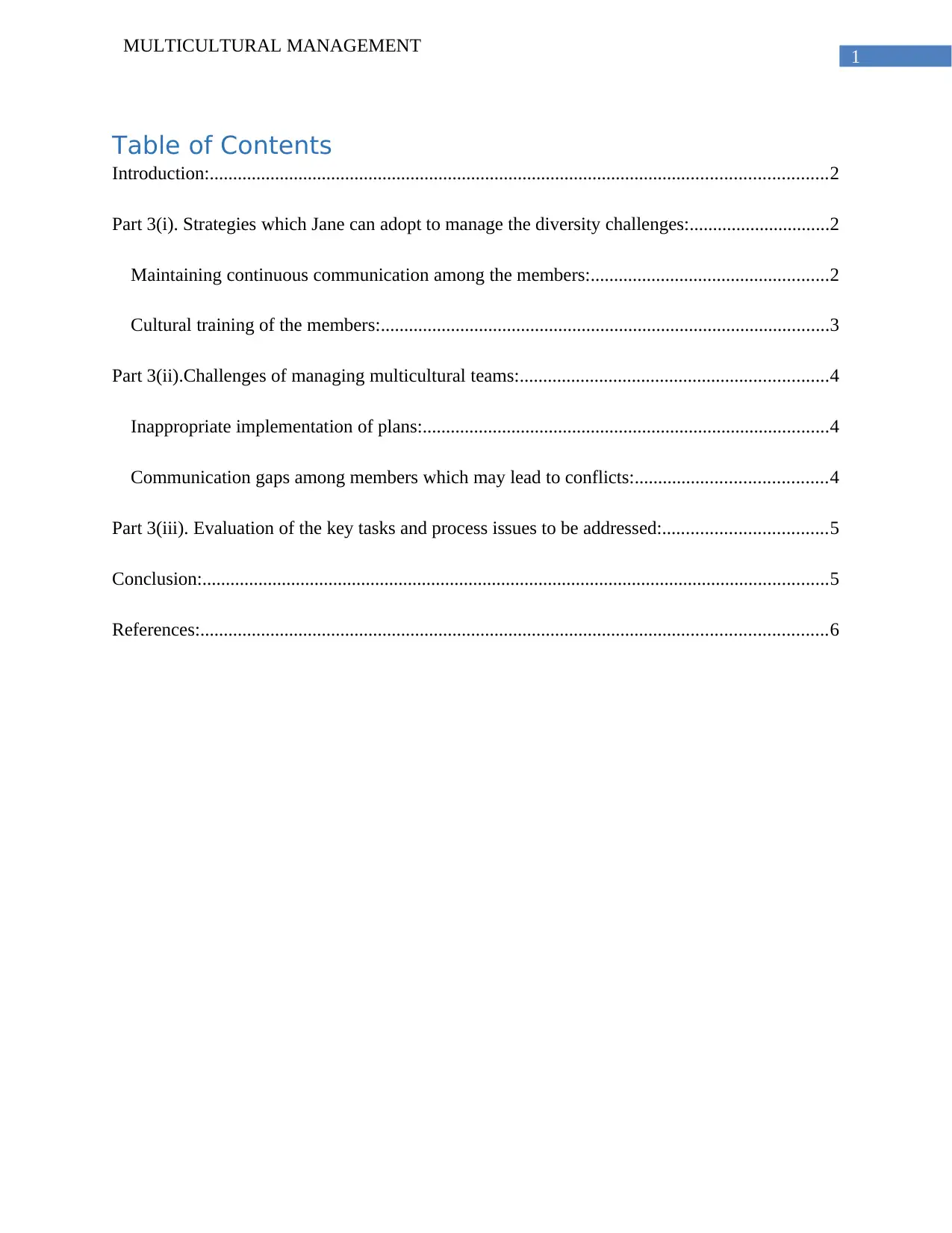
1
MULTICULTURAL MANAGEMENT
Table of Contents
Introduction:....................................................................................................................................2
Part 3(i). Strategies which Jane can adopt to manage the diversity challenges:..............................2
Maintaining continuous communication among the members:...................................................2
Cultural training of the members:................................................................................................3
Part 3(ii).Challenges of managing multicultural teams:..................................................................4
Inappropriate implementation of plans:.......................................................................................4
Communication gaps among members which may lead to conflicts:.........................................4
Part 3(iii). Evaluation of the key tasks and process issues to be addressed:...................................5
Conclusion:......................................................................................................................................5
References:......................................................................................................................................6
MULTICULTURAL MANAGEMENT
Table of Contents
Introduction:....................................................................................................................................2
Part 3(i). Strategies which Jane can adopt to manage the diversity challenges:..............................2
Maintaining continuous communication among the members:...................................................2
Cultural training of the members:................................................................................................3
Part 3(ii).Challenges of managing multicultural teams:..................................................................4
Inappropriate implementation of plans:.......................................................................................4
Communication gaps among members which may lead to conflicts:.........................................4
Part 3(iii). Evaluation of the key tasks and process issues to be addressed:...................................5
Conclusion:......................................................................................................................................5
References:......................................................................................................................................6
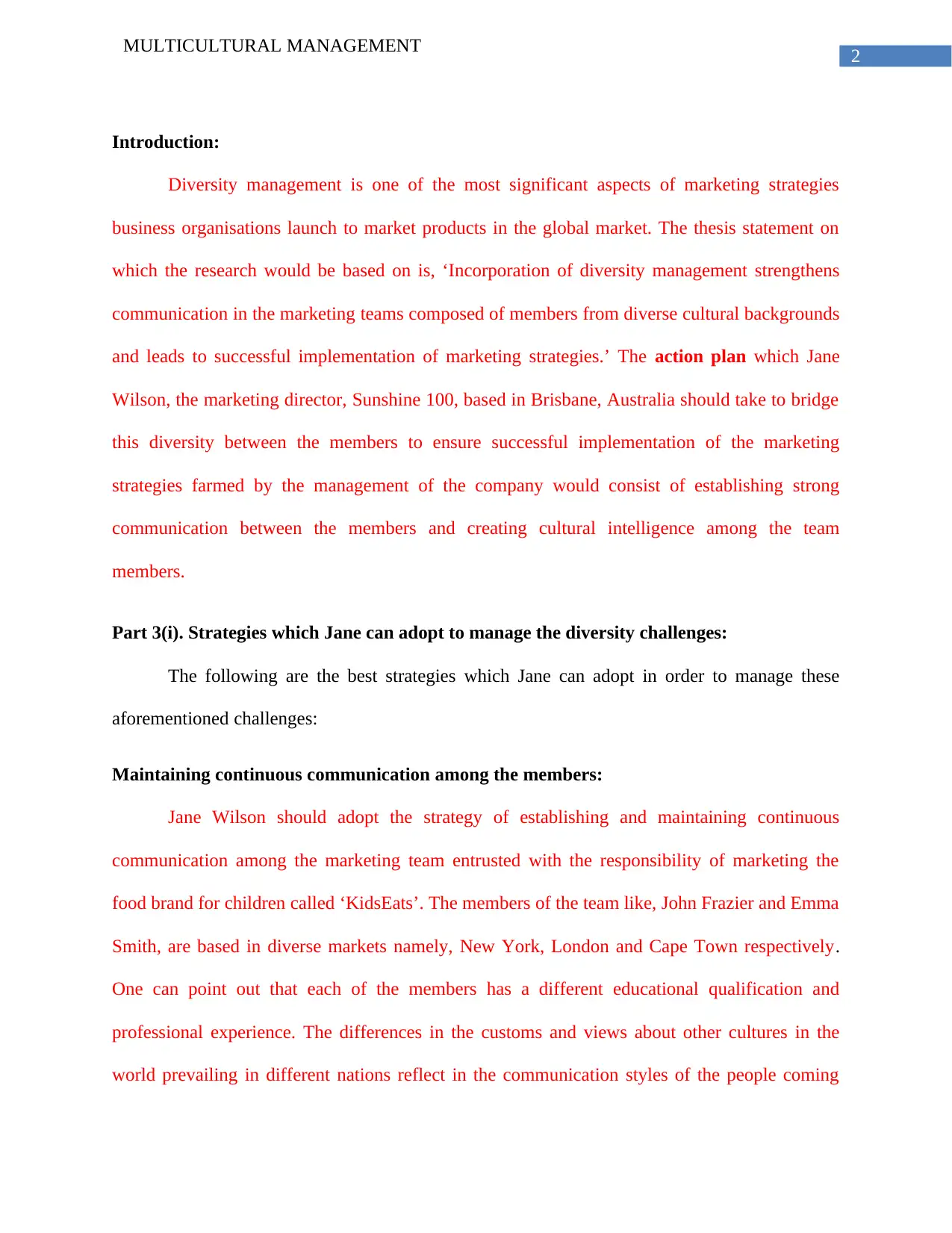
2
MULTICULTURAL MANAGEMENT
Introduction:
Diversity management is one of the most significant aspects of marketing strategies
business organisations launch to market products in the global market. The thesis statement on
which the research would be based on is, ‘Incorporation of diversity management strengthens
communication in the marketing teams composed of members from diverse cultural backgrounds
and leads to successful implementation of marketing strategies.’ The action plan which Jane
Wilson, the marketing director, Sunshine 100, based in Brisbane, Australia should take to bridge
this diversity between the members to ensure successful implementation of the marketing
strategies farmed by the management of the company would consist of establishing strong
communication between the members and creating cultural intelligence among the team
members.
Part 3(i). Strategies which Jane can adopt to manage the diversity challenges:
The following are the best strategies which Jane can adopt in order to manage these
aforementioned challenges:
Maintaining continuous communication among the members:
Jane Wilson should adopt the strategy of establishing and maintaining continuous
communication among the marketing team entrusted with the responsibility of marketing the
food brand for children called ‘KidsEats’. The members of the team like, John Frazier and Emma
Smith, are based in diverse markets namely, New York, London and Cape Town respectively.
One can point out that each of the members has a different educational qualification and
professional experience. The differences in the customs and views about other cultures in the
world prevailing in different nations reflect in the communication styles of the people coming
MULTICULTURAL MANAGEMENT
Introduction:
Diversity management is one of the most significant aspects of marketing strategies
business organisations launch to market products in the global market. The thesis statement on
which the research would be based on is, ‘Incorporation of diversity management strengthens
communication in the marketing teams composed of members from diverse cultural backgrounds
and leads to successful implementation of marketing strategies.’ The action plan which Jane
Wilson, the marketing director, Sunshine 100, based in Brisbane, Australia should take to bridge
this diversity between the members to ensure successful implementation of the marketing
strategies farmed by the management of the company would consist of establishing strong
communication between the members and creating cultural intelligence among the team
members.
Part 3(i). Strategies which Jane can adopt to manage the diversity challenges:
The following are the best strategies which Jane can adopt in order to manage these
aforementioned challenges:
Maintaining continuous communication among the members:
Jane Wilson should adopt the strategy of establishing and maintaining continuous
communication among the marketing team entrusted with the responsibility of marketing the
food brand for children called ‘KidsEats’. The members of the team like, John Frazier and Emma
Smith, are based in diverse markets namely, New York, London and Cape Town respectively.
One can point out that each of the members has a different educational qualification and
professional experience. The differences in the customs and views about other cultures in the
world prevailing in different nations reflect in the communication styles of the people coming
⊘ This is a preview!⊘
Do you want full access?
Subscribe today to unlock all pages.

Trusted by 1+ million students worldwide
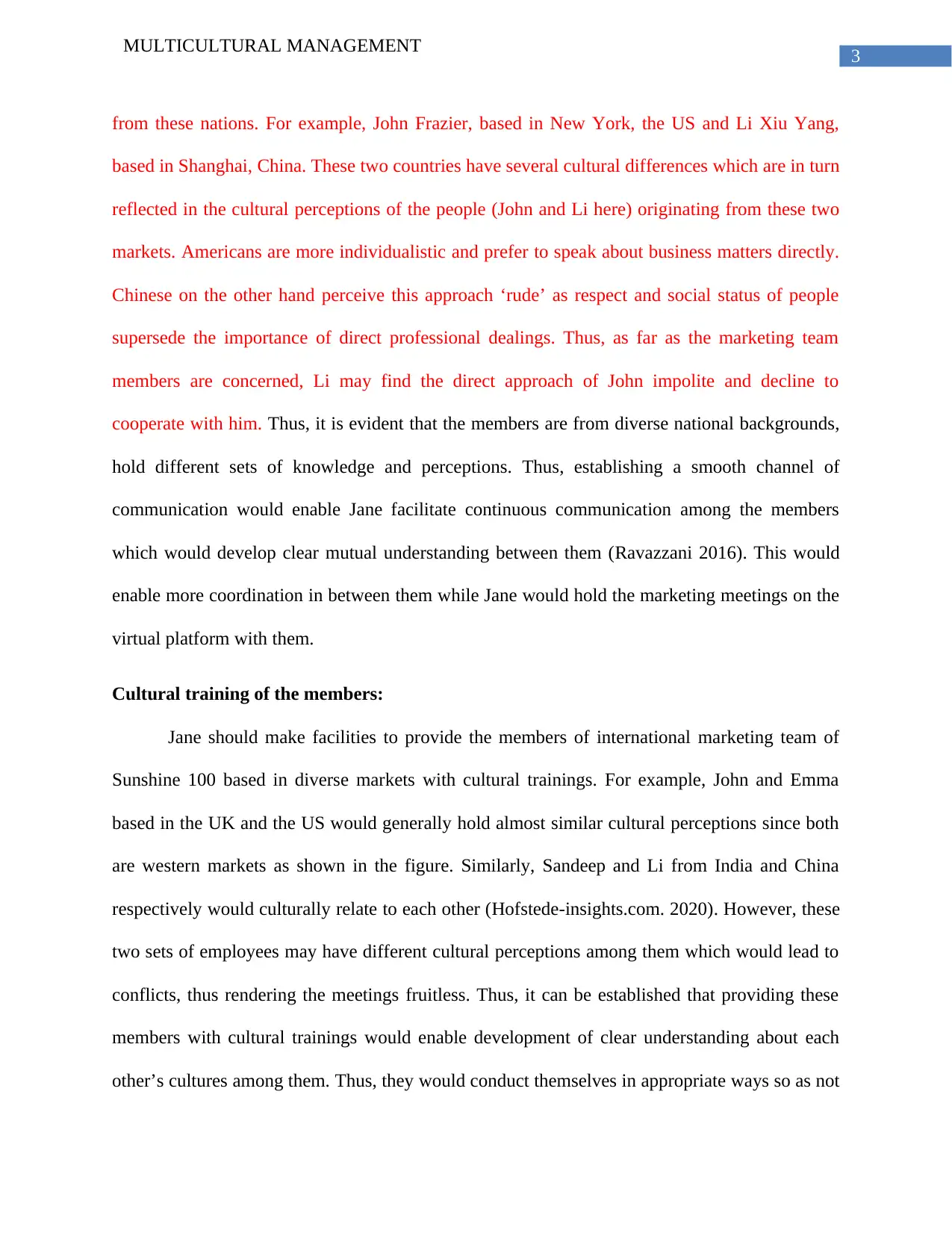
3
MULTICULTURAL MANAGEMENT
from these nations. For example, John Frazier, based in New York, the US and Li Xiu Yang,
based in Shanghai, China. These two countries have several cultural differences which are in turn
reflected in the cultural perceptions of the people (John and Li here) originating from these two
markets. Americans are more individualistic and prefer to speak about business matters directly.
Chinese on the other hand perceive this approach ‘rude’ as respect and social status of people
supersede the importance of direct professional dealings. Thus, as far as the marketing team
members are concerned, Li may find the direct approach of John impolite and decline to
cooperate with him. Thus, it is evident that the members are from diverse national backgrounds,
hold different sets of knowledge and perceptions. Thus, establishing a smooth channel of
communication would enable Jane facilitate continuous communication among the members
which would develop clear mutual understanding between them (Ravazzani 2016). This would
enable more coordination in between them while Jane would hold the marketing meetings on the
virtual platform with them.
Cultural training of the members:
Jane should make facilities to provide the members of international marketing team of
Sunshine 100 based in diverse markets with cultural trainings. For example, John and Emma
based in the UK and the US would generally hold almost similar cultural perceptions since both
are western markets as shown in the figure. Similarly, Sandeep and Li from India and China
respectively would culturally relate to each other (Hofstede-insights.com. 2020). However, these
two sets of employees may have different cultural perceptions among them which would lead to
conflicts, thus rendering the meetings fruitless. Thus, it can be established that providing these
members with cultural trainings would enable development of clear understanding about each
other’s cultures among them. Thus, they would conduct themselves in appropriate ways so as not
MULTICULTURAL MANAGEMENT
from these nations. For example, John Frazier, based in New York, the US and Li Xiu Yang,
based in Shanghai, China. These two countries have several cultural differences which are in turn
reflected in the cultural perceptions of the people (John and Li here) originating from these two
markets. Americans are more individualistic and prefer to speak about business matters directly.
Chinese on the other hand perceive this approach ‘rude’ as respect and social status of people
supersede the importance of direct professional dealings. Thus, as far as the marketing team
members are concerned, Li may find the direct approach of John impolite and decline to
cooperate with him. Thus, it is evident that the members are from diverse national backgrounds,
hold different sets of knowledge and perceptions. Thus, establishing a smooth channel of
communication would enable Jane facilitate continuous communication among the members
which would develop clear mutual understanding between them (Ravazzani 2016). This would
enable more coordination in between them while Jane would hold the marketing meetings on the
virtual platform with them.
Cultural training of the members:
Jane should make facilities to provide the members of international marketing team of
Sunshine 100 based in diverse markets with cultural trainings. For example, John and Emma
based in the UK and the US would generally hold almost similar cultural perceptions since both
are western markets as shown in the figure. Similarly, Sandeep and Li from India and China
respectively would culturally relate to each other (Hofstede-insights.com. 2020). However, these
two sets of employees may have different cultural perceptions among them which would lead to
conflicts, thus rendering the meetings fruitless. Thus, it can be established that providing these
members with cultural trainings would enable development of clear understanding about each
other’s cultures among them. Thus, they would conduct themselves in appropriate ways so as not
Paraphrase This Document
Need a fresh take? Get an instant paraphrase of this document with our AI Paraphraser
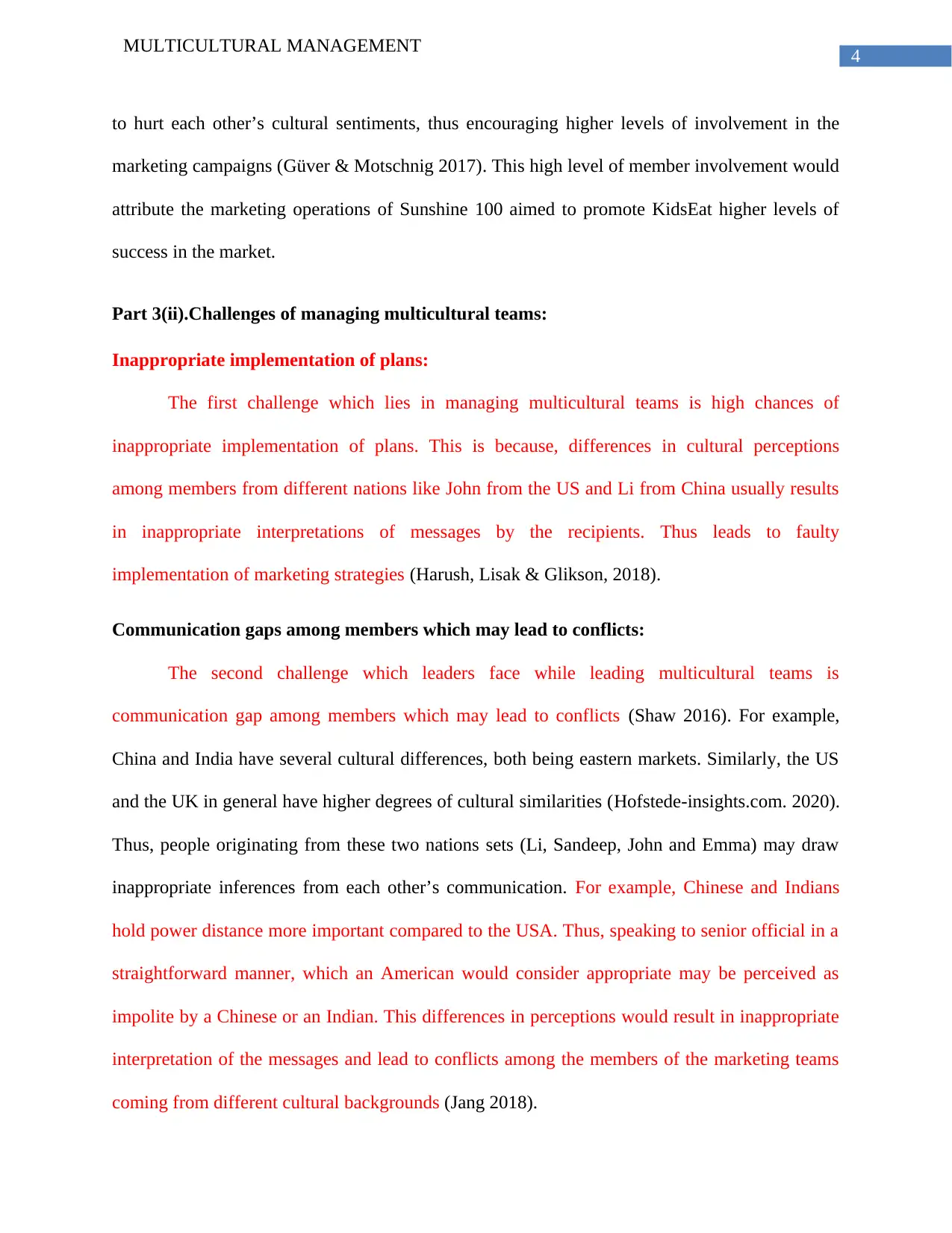
4
MULTICULTURAL MANAGEMENT
to hurt each other’s cultural sentiments, thus encouraging higher levels of involvement in the
marketing campaigns (Güver & Motschnig 2017). This high level of member involvement would
attribute the marketing operations of Sunshine 100 aimed to promote KidsEat higher levels of
success in the market.
Part 3(ii).Challenges of managing multicultural teams:
Inappropriate implementation of plans:
The first challenge which lies in managing multicultural teams is high chances of
inappropriate implementation of plans. This is because, differences in cultural perceptions
among members from different nations like John from the US and Li from China usually results
in inappropriate interpretations of messages by the recipients. Thus leads to faulty
implementation of marketing strategies (Harush, Lisak & Glikson, 2018).
Communication gaps among members which may lead to conflicts:
The second challenge which leaders face while leading multicultural teams is
communication gap among members which may lead to conflicts (Shaw 2016). For example,
China and India have several cultural differences, both being eastern markets. Similarly, the US
and the UK in general have higher degrees of cultural similarities (Hofstede-insights.com. 2020).
Thus, people originating from these two nations sets (Li, Sandeep, John and Emma) may draw
inappropriate inferences from each other’s communication. For example, Chinese and Indians
hold power distance more important compared to the USA. Thus, speaking to senior official in a
straightforward manner, which an American would consider appropriate may be perceived as
impolite by a Chinese or an Indian. This differences in perceptions would result in inappropriate
interpretation of the messages and lead to conflicts among the members of the marketing teams
coming from different cultural backgrounds (Jang 2018).
MULTICULTURAL MANAGEMENT
to hurt each other’s cultural sentiments, thus encouraging higher levels of involvement in the
marketing campaigns (Güver & Motschnig 2017). This high level of member involvement would
attribute the marketing operations of Sunshine 100 aimed to promote KidsEat higher levels of
success in the market.
Part 3(ii).Challenges of managing multicultural teams:
Inappropriate implementation of plans:
The first challenge which lies in managing multicultural teams is high chances of
inappropriate implementation of plans. This is because, differences in cultural perceptions
among members from different nations like John from the US and Li from China usually results
in inappropriate interpretations of messages by the recipients. Thus leads to faulty
implementation of marketing strategies (Harush, Lisak & Glikson, 2018).
Communication gaps among members which may lead to conflicts:
The second challenge which leaders face while leading multicultural teams is
communication gap among members which may lead to conflicts (Shaw 2016). For example,
China and India have several cultural differences, both being eastern markets. Similarly, the US
and the UK in general have higher degrees of cultural similarities (Hofstede-insights.com. 2020).
Thus, people originating from these two nations sets (Li, Sandeep, John and Emma) may draw
inappropriate inferences from each other’s communication. For example, Chinese and Indians
hold power distance more important compared to the USA. Thus, speaking to senior official in a
straightforward manner, which an American would consider appropriate may be perceived as
impolite by a Chinese or an Indian. This differences in perceptions would result in inappropriate
interpretation of the messages and lead to conflicts among the members of the marketing teams
coming from different cultural backgrounds (Jang 2018).
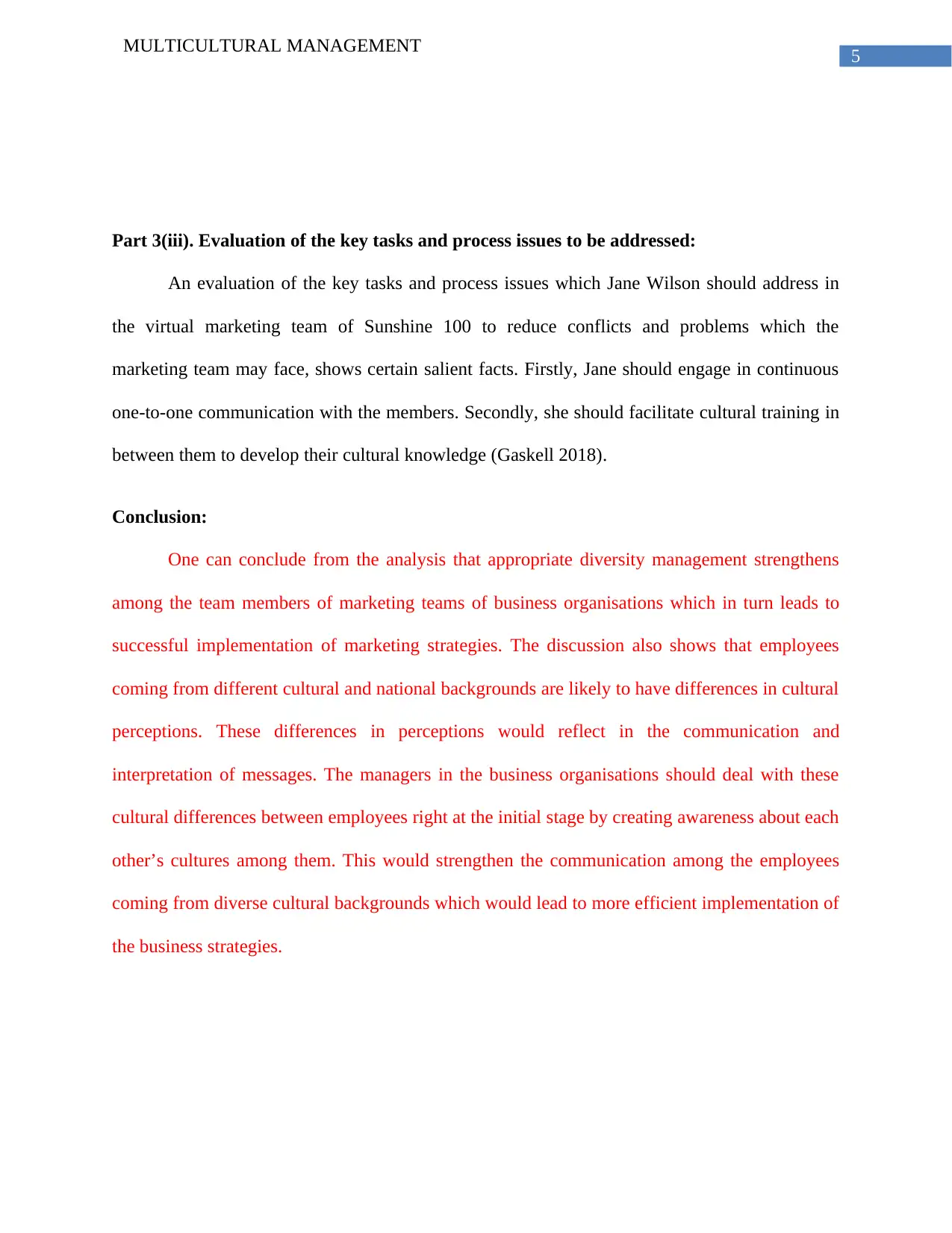
5
MULTICULTURAL MANAGEMENT
Part 3(iii). Evaluation of the key tasks and process issues to be addressed:
An evaluation of the key tasks and process issues which Jane Wilson should address in
the virtual marketing team of Sunshine 100 to reduce conflicts and problems which the
marketing team may face, shows certain salient facts. Firstly, Jane should engage in continuous
one-to-one communication with the members. Secondly, she should facilitate cultural training in
between them to develop their cultural knowledge (Gaskell 2018).
Conclusion:
One can conclude from the analysis that appropriate diversity management strengthens
among the team members of marketing teams of business organisations which in turn leads to
successful implementation of marketing strategies. The discussion also shows that employees
coming from different cultural and national backgrounds are likely to have differences in cultural
perceptions. These differences in perceptions would reflect in the communication and
interpretation of messages. The managers in the business organisations should deal with these
cultural differences between employees right at the initial stage by creating awareness about each
other’s cultures among them. This would strengthen the communication among the employees
coming from diverse cultural backgrounds which would lead to more efficient implementation of
the business strategies.
MULTICULTURAL MANAGEMENT
Part 3(iii). Evaluation of the key tasks and process issues to be addressed:
An evaluation of the key tasks and process issues which Jane Wilson should address in
the virtual marketing team of Sunshine 100 to reduce conflicts and problems which the
marketing team may face, shows certain salient facts. Firstly, Jane should engage in continuous
one-to-one communication with the members. Secondly, she should facilitate cultural training in
between them to develop their cultural knowledge (Gaskell 2018).
Conclusion:
One can conclude from the analysis that appropriate diversity management strengthens
among the team members of marketing teams of business organisations which in turn leads to
successful implementation of marketing strategies. The discussion also shows that employees
coming from different cultural and national backgrounds are likely to have differences in cultural
perceptions. These differences in perceptions would reflect in the communication and
interpretation of messages. The managers in the business organisations should deal with these
cultural differences between employees right at the initial stage by creating awareness about each
other’s cultures among them. This would strengthen the communication among the employees
coming from diverse cultural backgrounds which would lead to more efficient implementation of
the business strategies.
⊘ This is a preview!⊘
Do you want full access?
Subscribe today to unlock all pages.

Trusted by 1+ million students worldwide
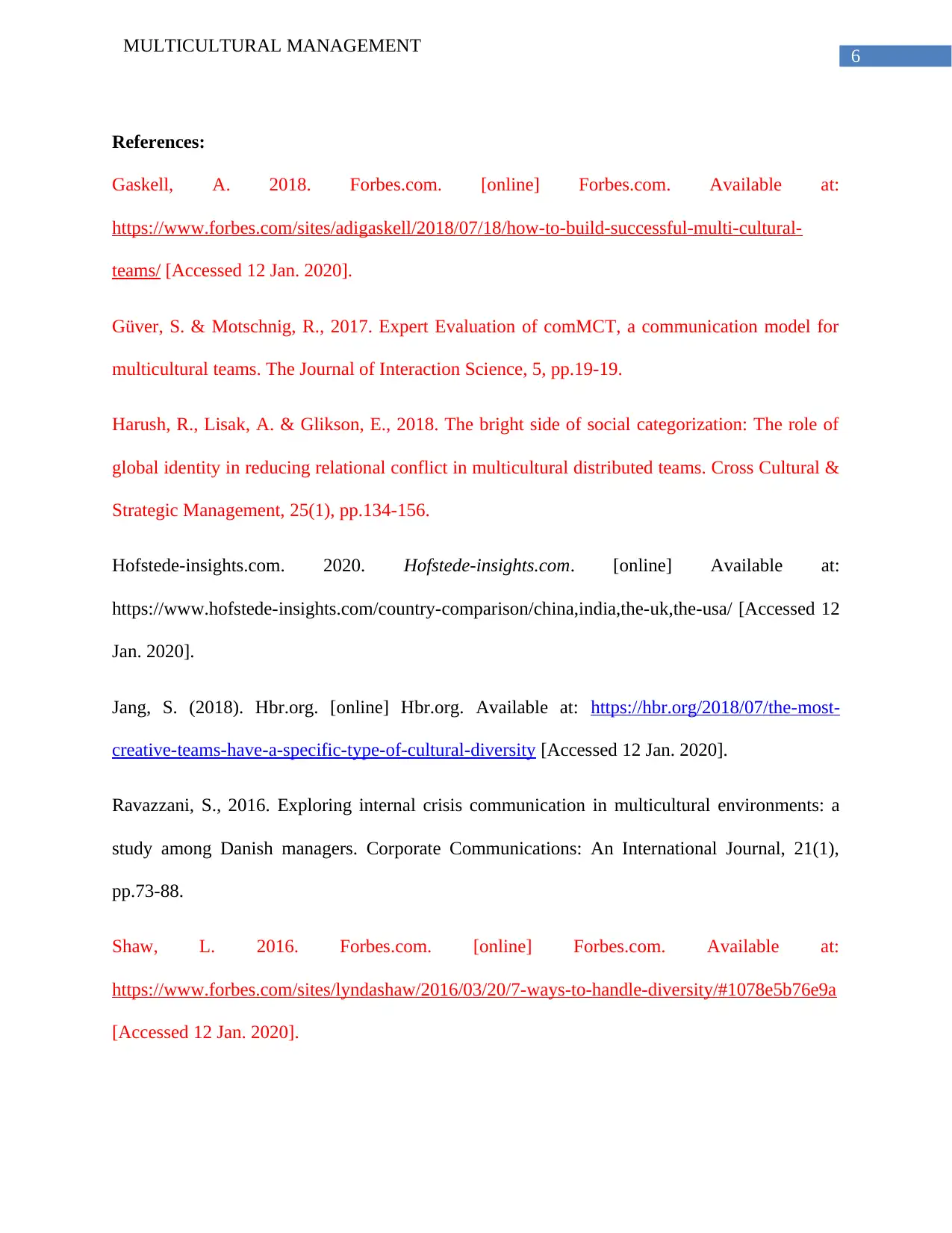
6
MULTICULTURAL MANAGEMENT
References:
Gaskell, A. 2018. Forbes.com. [online] Forbes.com. Available at:
https://www.forbes.com/sites/adigaskell/2018/07/18/how-to-build-successful-multi-cultural-
teams/ [Accessed 12 Jan. 2020].
Güver, S. & Motschnig, R., 2017. Expert Evaluation of comMCT, a communication model for
multicultural teams. The Journal of Interaction Science, 5, pp.19-19.
Harush, R., Lisak, A. & Glikson, E., 2018. The bright side of social categorization: The role of
global identity in reducing relational conflict in multicultural distributed teams. Cross Cultural &
Strategic Management, 25(1), pp.134-156.
Hofstede-insights.com. 2020. Hofstede-insights.com. [online] Available at:
https://www.hofstede-insights.com/country-comparison/china,india,the-uk,the-usa/ [Accessed 12
Jan. 2020].
Jang, S. (2018). Hbr.org. [online] Hbr.org. Available at: https://hbr.org/2018/07/the-most-
creative-teams-have-a-specific-type-of-cultural-diversity [Accessed 12 Jan. 2020].
Ravazzani, S., 2016. Exploring internal crisis communication in multicultural environments: a
study among Danish managers. Corporate Communications: An International Journal, 21(1),
pp.73-88.
Shaw, L. 2016. Forbes.com. [online] Forbes.com. Available at:
https://www.forbes.com/sites/lyndashaw/2016/03/20/7-ways-to-handle-diversity/#1078e5b76e9a
[Accessed 12 Jan. 2020].
MULTICULTURAL MANAGEMENT
References:
Gaskell, A. 2018. Forbes.com. [online] Forbes.com. Available at:
https://www.forbes.com/sites/adigaskell/2018/07/18/how-to-build-successful-multi-cultural-
teams/ [Accessed 12 Jan. 2020].
Güver, S. & Motschnig, R., 2017. Expert Evaluation of comMCT, a communication model for
multicultural teams. The Journal of Interaction Science, 5, pp.19-19.
Harush, R., Lisak, A. & Glikson, E., 2018. The bright side of social categorization: The role of
global identity in reducing relational conflict in multicultural distributed teams. Cross Cultural &
Strategic Management, 25(1), pp.134-156.
Hofstede-insights.com. 2020. Hofstede-insights.com. [online] Available at:
https://www.hofstede-insights.com/country-comparison/china,india,the-uk,the-usa/ [Accessed 12
Jan. 2020].
Jang, S. (2018). Hbr.org. [online] Hbr.org. Available at: https://hbr.org/2018/07/the-most-
creative-teams-have-a-specific-type-of-cultural-diversity [Accessed 12 Jan. 2020].
Ravazzani, S., 2016. Exploring internal crisis communication in multicultural environments: a
study among Danish managers. Corporate Communications: An International Journal, 21(1),
pp.73-88.
Shaw, L. 2016. Forbes.com. [online] Forbes.com. Available at:
https://www.forbes.com/sites/lyndashaw/2016/03/20/7-ways-to-handle-diversity/#1078e5b76e9a
[Accessed 12 Jan. 2020].
1 out of 7
Related Documents
Your All-in-One AI-Powered Toolkit for Academic Success.
+13062052269
info@desklib.com
Available 24*7 on WhatsApp / Email
![[object Object]](/_next/static/media/star-bottom.7253800d.svg)
Unlock your academic potential
Copyright © 2020–2025 A2Z Services. All Rights Reserved. Developed and managed by ZUCOL.





